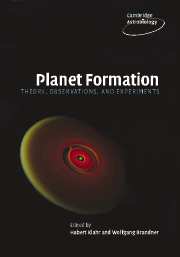Book contents
- Frontmatter
- Contents
- Preface
- Acknowledgments
- 1 Historical notes on planet formation
- 2 The Formation and Evolution of Planetary Systems: placing our Solar System in context
- 3 Destruction of protoplanetary disks by photoevaporation
- 4 Turbulence in protoplanetary accretion disks: driving mechanisms and role in planet formation
- 5 The origin of solids in the early Solar System
- 6 Experiments on planetesimal formation
- 7 Dust coagulation in protoplanetary disks
- 8 The accretion of giant planet cores
- 9 Planetary transits: a first direct vision of extrasolar planets
- 10 The core accretion–gas capture model for gas-giant planet formation
- 11 Properties of exoplanets: a Doppler study of 1330 stars
- 12 Giant-planet formation: theories meet observations
- 13 From hot Jupiters to hot Neptunes … and below
- 14 Disk–planet interaction and migration
- 15 The brown dwarf–planet relation
- 16 Exoplanet detection techniques – from astronomy to astrobiology
- 17 Overview and prospective in theory and observation of planet formation
- References
- Index
10 - The core accretion–gas capture model for gas-giant planet formation
Published online by Cambridge University Press: 14 September 2009
- Frontmatter
- Contents
- Preface
- Acknowledgments
- 1 Historical notes on planet formation
- 2 The Formation and Evolution of Planetary Systems: placing our Solar System in context
- 3 Destruction of protoplanetary disks by photoevaporation
- 4 Turbulence in protoplanetary accretion disks: driving mechanisms and role in planet formation
- 5 The origin of solids in the early Solar System
- 6 Experiments on planetesimal formation
- 7 Dust coagulation in protoplanetary disks
- 8 The accretion of giant planet cores
- 9 Planetary transits: a first direct vision of extrasolar planets
- 10 The core accretion–gas capture model for gas-giant planet formation
- 11 Properties of exoplanets: a Doppler study of 1330 stars
- 12 Giant-planet formation: theories meet observations
- 13 From hot Jupiters to hot Neptunes … and below
- 14 Disk–planet interaction and migration
- 15 The brown dwarf–planet relation
- 16 Exoplanet detection techniques – from astronomy to astrobiology
- 17 Overview and prospective in theory and observation of planet formation
- References
- Index
Summary
Introduction
At the time of this workshop, there are now more than 150 detected extrasolar planets discovered and 13 confirmed multiple planet systems with more candidate planets and systems being evaluated (G. Marcy in Chapter 11 of this book). There is a growing number of ground-based observations of young circumstellar and protoplanetary disks as well as volumes of data from Spitzer and Cassini. There are two scenarios for gas-giant planet formation that are sufficiently sophisticated to provide results and predictions. Clearly, the ingredients are present for planetary scientists to develop a comprehensive or, at least, a cohesive model for the formation of the gas-giant planets in the Solar System and in extrasolar systems and, to initiate resolution of the age old question: how do planets form?
The subject of this chapter is the core accretion–gas capture model, the more generally accepted scenario for gas-giant planet formation (see also Chapter 8 by Thommes and Duncan for the core accretion itself). Please note that this model has had many names over the decades of its development: planetesimal hypothesis, nucleated instability model, and core instability model. However, it seems best to call it by the more descriptive label: the Core Accretion–Gas Capture model, the CAGC or, the short version, the core accretion model.
- Type
- Chapter
- Information
- Planet FormationTheory, Observations, and Experiments, pp. 163 - 178Publisher: Cambridge University PressPrint publication year: 2006
- 3
- Cited by

